Financial Management: Assessing Business Performance Through Ratios
VerifiedAdded on 2023/06/14
|11
|2897
|231
Report
AI Summary
This report provides a detailed analysis of financial management, emphasizing the importance of effective fund acquisition and utilization for increased business profitability. It explores core concepts, including financial planning, safeguarding business funds, creating investment opportunities, and tax management. The report elaborates on key financial statements such as the income statement, cash flow statement, and balance sheet, highlighting their role in assessing a company's financial position. It also delves into the application of financial ratios—profitability, efficiency, and liquidity ratios—to measure and compare financial performance, interpret operational efficiency, and evaluate the ability to meet short-term obligations. The analysis includes calculations and interpretations of these ratios for the year 2016, offering insights into the company's profitability, asset utilization, and liquidity management. The report concludes with recommendations for improving financial performance, focusing on debt management, cost control, and strategic financial planning to enhance long-term business sustainability and growth. Desklib provides similar solved assignments and past papers for students.

BUSINESS
Paraphrase This Document
Need a fresh take? Get an instant paraphrase of this document with our AI Paraphraser
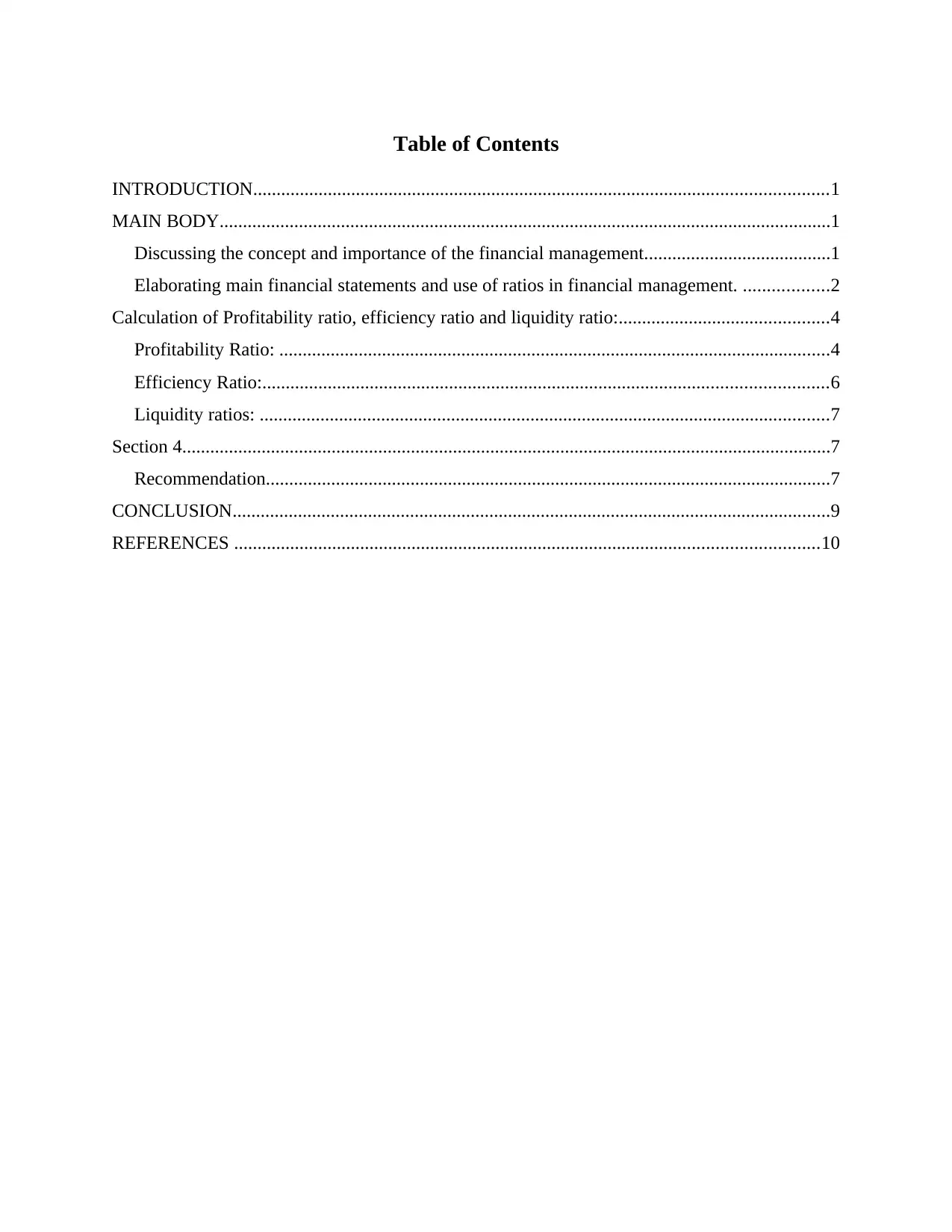
Table of Contents
INTRODUCTION...........................................................................................................................1
MAIN BODY...................................................................................................................................1
Discussing the concept and importance of the financial management........................................1
Elaborating main financial statements and use of ratios in financial management. ..................2
Calculation of Profitability ratio, efficiency ratio and liquidity ratio:.............................................4
Profitability Ratio: ......................................................................................................................4
Efficiency Ratio:.........................................................................................................................6
Liquidity ratios: ..........................................................................................................................7
Section 4...........................................................................................................................................7
Recommendation.........................................................................................................................7
CONCLUSION................................................................................................................................9
REFERENCES .............................................................................................................................10
INTRODUCTION...........................................................................................................................1
MAIN BODY...................................................................................................................................1
Discussing the concept and importance of the financial management........................................1
Elaborating main financial statements and use of ratios in financial management. ..................2
Calculation of Profitability ratio, efficiency ratio and liquidity ratio:.............................................4
Profitability Ratio: ......................................................................................................................4
Efficiency Ratio:.........................................................................................................................6
Liquidity ratios: ..........................................................................................................................7
Section 4...........................................................................................................................................7
Recommendation.........................................................................................................................7
CONCLUSION................................................................................................................................9
REFERENCES .............................................................................................................................10
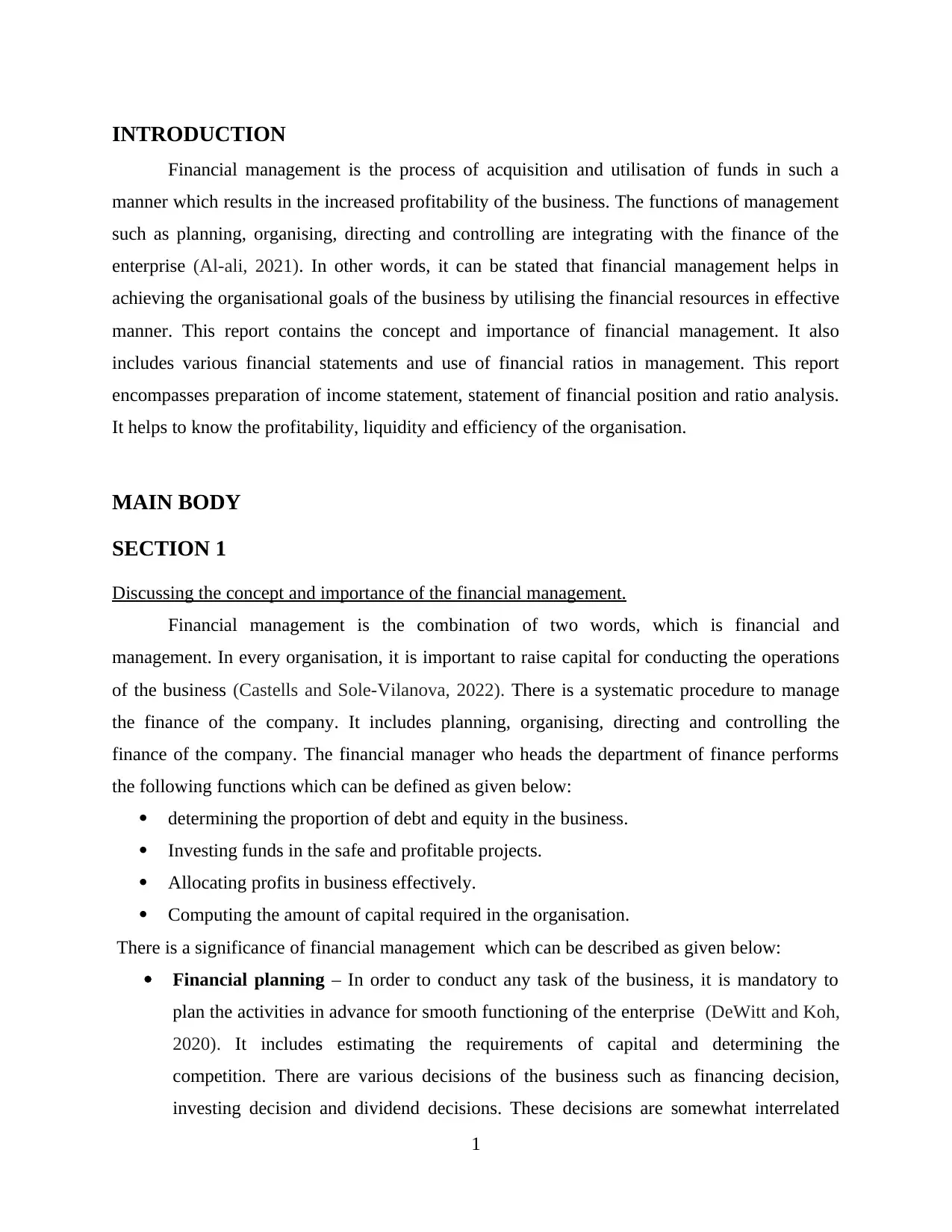
INTRODUCTION
Financial management is the process of acquisition and utilisation of funds in such a
manner which results in the increased profitability of the business. The functions of management
such as planning, organising, directing and controlling are integrating with the finance of the
enterprise (Al-ali, 2021). In other words, it can be stated that financial management helps in
achieving the organisational goals of the business by utilising the financial resources in effective
manner. This report contains the concept and importance of financial management. It also
includes various financial statements and use of financial ratios in management. This report
encompasses preparation of income statement, statement of financial position and ratio analysis.
It helps to know the profitability, liquidity and efficiency of the organisation.
MAIN BODY
SECTION 1
Discussing the concept and importance of the financial management.
Financial management is the combination of two words, which is financial and
management. In every organisation, it is important to raise capital for conducting the operations
of the business (Castells and Sole-Vilanova, 2022). There is a systematic procedure to manage
the finance of the company. It includes planning, organising, directing and controlling the
finance of the company. The financial manager who heads the department of finance performs
the following functions which can be defined as given below:
determining the proportion of debt and equity in the business.
Investing funds in the safe and profitable projects.
Allocating profits in business effectively.
Computing the amount of capital required in the organisation.
There is a significance of financial management which can be described as given below:
Financial planning – In order to conduct any task of the business, it is mandatory to
plan the activities in advance for smooth functioning of the enterprise (DeWitt and Koh,
2020). It includes estimating the requirements of capital and determining the
competition. There are various decisions of the business such as financing decision,
investing decision and dividend decisions. These decisions are somewhat interrelated
1
Financial management is the process of acquisition and utilisation of funds in such a
manner which results in the increased profitability of the business. The functions of management
such as planning, organising, directing and controlling are integrating with the finance of the
enterprise (Al-ali, 2021). In other words, it can be stated that financial management helps in
achieving the organisational goals of the business by utilising the financial resources in effective
manner. This report contains the concept and importance of financial management. It also
includes various financial statements and use of financial ratios in management. This report
encompasses preparation of income statement, statement of financial position and ratio analysis.
It helps to know the profitability, liquidity and efficiency of the organisation.
MAIN BODY
SECTION 1
Discussing the concept and importance of the financial management.
Financial management is the combination of two words, which is financial and
management. In every organisation, it is important to raise capital for conducting the operations
of the business (Castells and Sole-Vilanova, 2022). There is a systematic procedure to manage
the finance of the company. It includes planning, organising, directing and controlling the
finance of the company. The financial manager who heads the department of finance performs
the following functions which can be defined as given below:
determining the proportion of debt and equity in the business.
Investing funds in the safe and profitable projects.
Allocating profits in business effectively.
Computing the amount of capital required in the organisation.
There is a significance of financial management which can be described as given below:
Financial planning – In order to conduct any task of the business, it is mandatory to
plan the activities in advance for smooth functioning of the enterprise (DeWitt and Koh,
2020). It includes estimating the requirements of capital and determining the
competition. There are various decisions of the business such as financing decision,
investing decision and dividend decisions. These decisions are somewhat interrelated
1
⊘ This is a preview!⊘
Do you want full access?
Subscribe today to unlock all pages.

Trusted by 1+ million students worldwide
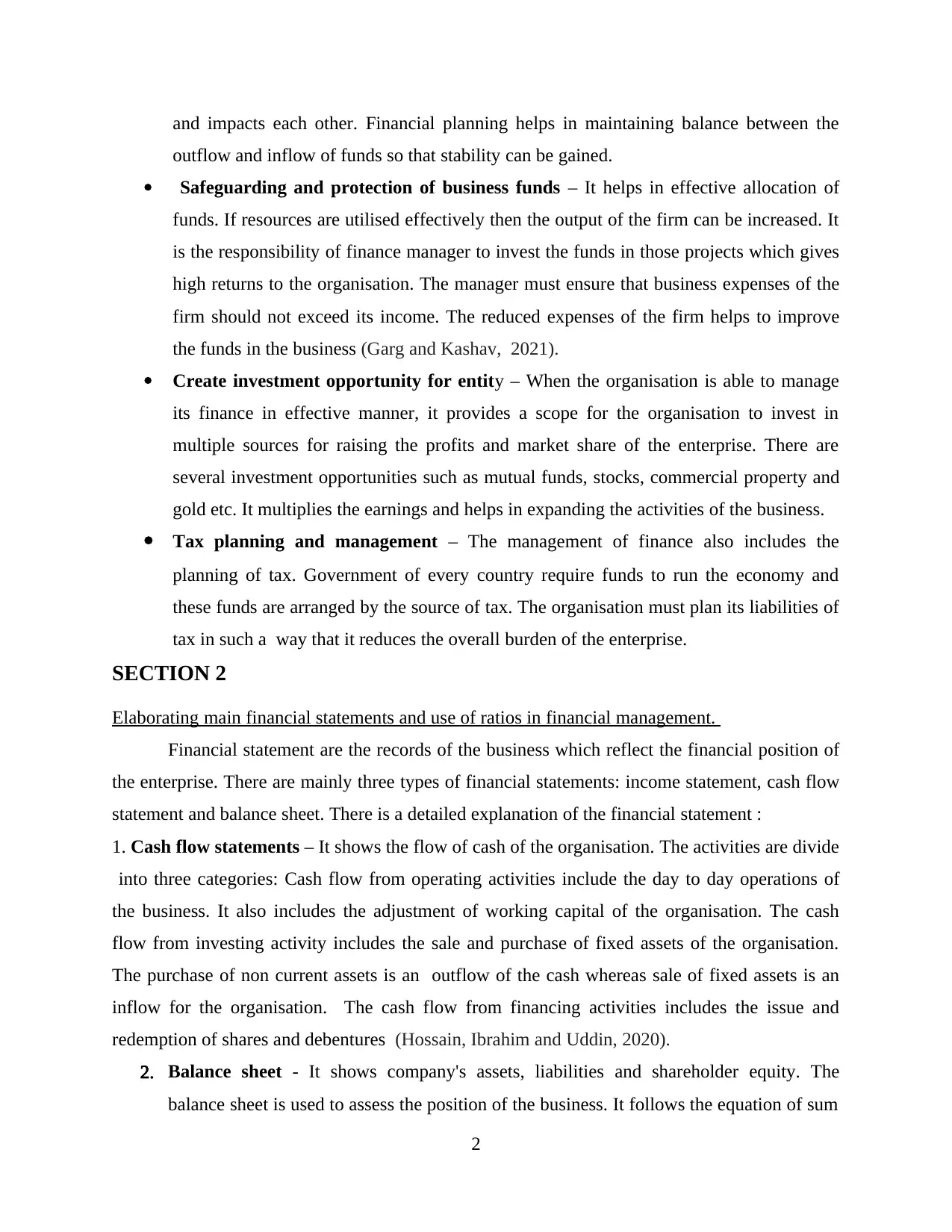
and impacts each other. Financial planning helps in maintaining balance between the
outflow and inflow of funds so that stability can be gained.
Safeguarding and protection of business funds – It helps in effective allocation of
funds. If resources are utilised effectively then the output of the firm can be increased. It
is the responsibility of finance manager to invest the funds in those projects which gives
high returns to the organisation. The manager must ensure that business expenses of the
firm should not exceed its income. The reduced expenses of the firm helps to improve
the funds in the business (Garg and Kashav, 2021).
Create investment opportunity for entity – When the organisation is able to manage
its finance in effective manner, it provides a scope for the organisation to invest in
multiple sources for raising the profits and market share of the enterprise. There are
several investment opportunities such as mutual funds, stocks, commercial property and
gold etc. It multiplies the earnings and helps in expanding the activities of the business.
Tax planning and management – The management of finance also includes the
planning of tax. Government of every country require funds to run the economy and
these funds are arranged by the source of tax. The organisation must plan its liabilities of
tax in such a way that it reduces the overall burden of the enterprise.
SECTION 2
Elaborating main financial statements and use of ratios in financial management.
Financial statement are the records of the business which reflect the financial position of
the enterprise. There are mainly three types of financial statements: income statement, cash flow
statement and balance sheet. There is a detailed explanation of the financial statement :
1. Cash flow statements – It shows the flow of cash of the organisation. The activities are divide
into three categories: Cash flow from operating activities include the day to day operations of
the business. It also includes the adjustment of working capital of the organisation. The cash
flow from investing activity includes the sale and purchase of fixed assets of the organisation.
The purchase of non current assets is an outflow of the cash whereas sale of fixed assets is an
inflow for the organisation. The cash flow from financing activities includes the issue and
redemption of shares and debentures (Hossain, Ibrahim and Uddin, 2020).
2. Balance sheet - It shows company's assets, liabilities and shareholder equity. The
balance sheet is used to assess the position of the business. It follows the equation of sum
2
outflow and inflow of funds so that stability can be gained.
Safeguarding and protection of business funds – It helps in effective allocation of
funds. If resources are utilised effectively then the output of the firm can be increased. It
is the responsibility of finance manager to invest the funds in those projects which gives
high returns to the organisation. The manager must ensure that business expenses of the
firm should not exceed its income. The reduced expenses of the firm helps to improve
the funds in the business (Garg and Kashav, 2021).
Create investment opportunity for entity – When the organisation is able to manage
its finance in effective manner, it provides a scope for the organisation to invest in
multiple sources for raising the profits and market share of the enterprise. There are
several investment opportunities such as mutual funds, stocks, commercial property and
gold etc. It multiplies the earnings and helps in expanding the activities of the business.
Tax planning and management – The management of finance also includes the
planning of tax. Government of every country require funds to run the economy and
these funds are arranged by the source of tax. The organisation must plan its liabilities of
tax in such a way that it reduces the overall burden of the enterprise.
SECTION 2
Elaborating main financial statements and use of ratios in financial management.
Financial statement are the records of the business which reflect the financial position of
the enterprise. There are mainly three types of financial statements: income statement, cash flow
statement and balance sheet. There is a detailed explanation of the financial statement :
1. Cash flow statements – It shows the flow of cash of the organisation. The activities are divide
into three categories: Cash flow from operating activities include the day to day operations of
the business. It also includes the adjustment of working capital of the organisation. The cash
flow from investing activity includes the sale and purchase of fixed assets of the organisation.
The purchase of non current assets is an outflow of the cash whereas sale of fixed assets is an
inflow for the organisation. The cash flow from financing activities includes the issue and
redemption of shares and debentures (Hossain, Ibrahim and Uddin, 2020).
2. Balance sheet - It shows company's assets, liabilities and shareholder equity. The
balance sheet is used to assess the position of the business. It follows the equation of sum
2
Paraphrase This Document
Need a fresh take? Get an instant paraphrase of this document with our AI Paraphraser

of all the assets are equal to the sum of shareholder's equity. The balance sheet mainly
includes the assets and liabilities. The assets of the organisation are further divided into
current assets and non current assets. Current assets are those assets which remain in the
business up to the period of twelve months. Examples of current assets include debtors
and bill receivable. On the other hand, non current assets are those assets which remain in
business for more than twelve months. Examples of non current assets include plant &
machinery and other fixtures. The liabilities of the balance sheet are further classified into
two types: current liabilities and non current liabilities. Examples of current liabilities are
creditors and bill payable (Kleibert, 2020). The items included in the balance sheet assist
in finding financial ratios of the organisation. Another purpose of balance sheet is to
provide an comprehensive view about the organisation. For identifying the trends of the
organisation, balance sheet helps in studying the trends. It also helps to know the source
of finance used by the company. It gives insights to the investors whether it is profitable
or not. In simple words, assets are the items which an organisation owns. Liabilities are
those items what an enterprise owes. The bank and financial institutions uses balance
sheet to know the financial position through which an organisation can demand loans and
credit.
3. Profit and loss - It can be explained as a statement which reflects company's generated
revenue and incurred expenses & losses as well. It helps to ascertain whether a company
is earning enough profit to carry out its future operations and related activities. It also
gives an idea about current financial position of a business in economy and how it can be
improved. It is useful for enterprises to generate income and assess the stability &
sustainability in competitive market (Machmud, Herlinawati and Supriyadi, 2018).
Income statement helps to calculate taxes that are to be paid by the organisation and its
liquidity position as well. It further serves as a guide to calculate revenue earned,
expenses generated, cost involved in sale of goods, profit recorded after eliminating all
expense and losses.
Importance of income statement:
Help investors and creditors to assess previous year performances carried out in an
organisation.
It also serves as a technique to predict future related risks and opportunities.
3
includes the assets and liabilities. The assets of the organisation are further divided into
current assets and non current assets. Current assets are those assets which remain in the
business up to the period of twelve months. Examples of current assets include debtors
and bill receivable. On the other hand, non current assets are those assets which remain in
business for more than twelve months. Examples of non current assets include plant &
machinery and other fixtures. The liabilities of the balance sheet are further classified into
two types: current liabilities and non current liabilities. Examples of current liabilities are
creditors and bill payable (Kleibert, 2020). The items included in the balance sheet assist
in finding financial ratios of the organisation. Another purpose of balance sheet is to
provide an comprehensive view about the organisation. For identifying the trends of the
organisation, balance sheet helps in studying the trends. It also helps to know the source
of finance used by the company. It gives insights to the investors whether it is profitable
or not. In simple words, assets are the items which an organisation owns. Liabilities are
those items what an enterprise owes. The bank and financial institutions uses balance
sheet to know the financial position through which an organisation can demand loans and
credit.
3. Profit and loss - It can be explained as a statement which reflects company's generated
revenue and incurred expenses & losses as well. It helps to ascertain whether a company
is earning enough profit to carry out its future operations and related activities. It also
gives an idea about current financial position of a business in economy and how it can be
improved. It is useful for enterprises to generate income and assess the stability &
sustainability in competitive market (Machmud, Herlinawati and Supriyadi, 2018).
Income statement helps to calculate taxes that are to be paid by the organisation and its
liquidity position as well. It further serves as a guide to calculate revenue earned,
expenses generated, cost involved in sale of goods, profit recorded after eliminating all
expense and losses.
Importance of income statement:
Help investors and creditors to assess previous year performances carried out in an
organisation.
It also serves as a technique to predict future related risks and opportunities.
3

It evaluates the ability to generate cash flow with the help of report prepared taking in
account all incomes and losses.
Limitation of income statement:
It is possible that the figures calculated so far are not reliable and accurate.
Some results depend on the accounting method applied such as LIFO or FIFO (McDonald and
Jordan, 2021).
Financial ratios – It is used to measure the financial performance of the organisation. There are
various importance of financial ratios which can be explained as given below -
It helps to compare the financial performance with the competitors.
Ratios assist the management in decision making.
It helps in developing and understanding different financial items of balance sheet.
Calculation of Profitability ratio, efficiency ratio and liquidity ratio:
◦ Profitability Ratio:
It can be explained as a type of accounting based ratio that is helpful in evaluating
financial performance of company for the year. These ratios help to reflect working of a
organisation as how efficiently a firm is able to generate profits and revenues through operations.
There are many types of profitability ratios such as Operating profit ratio, gross profit ratio,
return on investment, net profit ratio etc. Gross profit ratio helps to measure the relation between
net sales carried and gross profit earned (Sokolova, Sokolova and Golotvina, 2020). Net profit
ratio help to form relationship between net profit after tax and net sales. It also serves as a guide
towards investors for deciding whether the business is able to carry out adequate profit from
sales made and what are the cost related to operating and overhead are being incurred.
Calculation of profitability ratios for year 2016 is as under:
4
account all incomes and losses.
Limitation of income statement:
It is possible that the figures calculated so far are not reliable and accurate.
Some results depend on the accounting method applied such as LIFO or FIFO (McDonald and
Jordan, 2021).
Financial ratios – It is used to measure the financial performance of the organisation. There are
various importance of financial ratios which can be explained as given below -
It helps to compare the financial performance with the competitors.
Ratios assist the management in decision making.
It helps in developing and understanding different financial items of balance sheet.
Calculation of Profitability ratio, efficiency ratio and liquidity ratio:
◦ Profitability Ratio:
It can be explained as a type of accounting based ratio that is helpful in evaluating
financial performance of company for the year. These ratios help to reflect working of a
organisation as how efficiently a firm is able to generate profits and revenues through operations.
There are many types of profitability ratios such as Operating profit ratio, gross profit ratio,
return on investment, net profit ratio etc. Gross profit ratio helps to measure the relation between
net sales carried and gross profit earned (Sokolova, Sokolova and Golotvina, 2020). Net profit
ratio help to form relationship between net profit after tax and net sales. It also serves as a guide
towards investors for deciding whether the business is able to carry out adequate profit from
sales made and what are the cost related to operating and overhead are being incurred.
Calculation of profitability ratios for year 2016 is as under:
4
⊘ This is a preview!⊘
Do you want full access?
Subscribe today to unlock all pages.

Trusted by 1+ million students worldwide
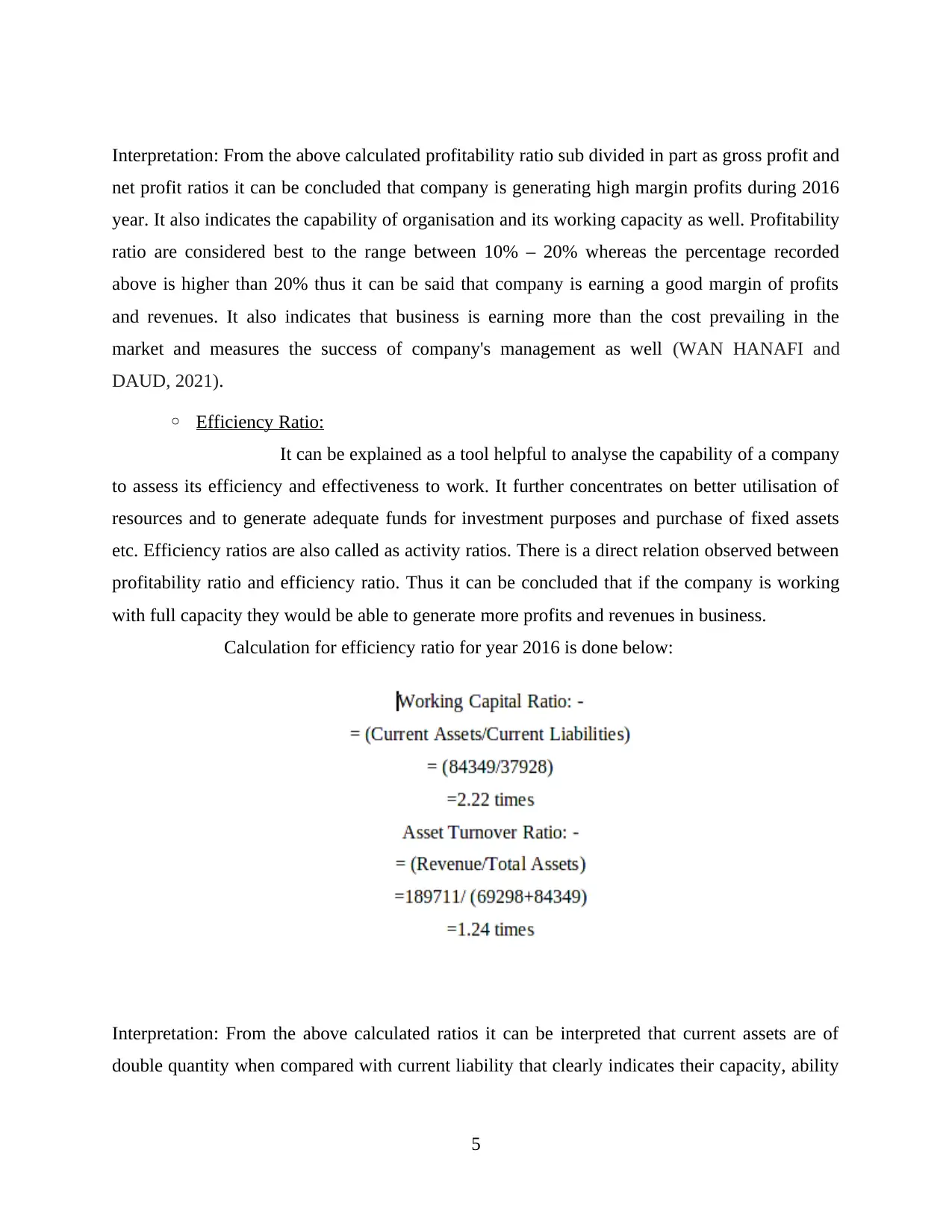
Interpretation: From the above calculated profitability ratio sub divided in part as gross profit and
net profit ratios it can be concluded that company is generating high margin profits during 2016
year. It also indicates the capability of organisation and its working capacity as well. Profitability
ratio are considered best to the range between 10% – 20% whereas the percentage recorded
above is higher than 20% thus it can be said that company is earning a good margin of profits
and revenues. It also indicates that business is earning more than the cost prevailing in the
market and measures the success of company's management as well (WAN HANAFI and
DAUD, 2021).
◦ Efficiency Ratio:
It can be explained as a tool helpful to analyse the capability of a company
to assess its efficiency and effectiveness to work. It further concentrates on better utilisation of
resources and to generate adequate funds for investment purposes and purchase of fixed assets
etc. Efficiency ratios are also called as activity ratios. There is a direct relation observed between
profitability ratio and efficiency ratio. Thus it can be concluded that if the company is working
with full capacity they would be able to generate more profits and revenues in business.
Calculation for efficiency ratio for year 2016 is done below:
Interpretation: From the above calculated ratios it can be interpreted that current assets are of
double quantity when compared with current liability that clearly indicates their capacity, ability
5
net profit ratios it can be concluded that company is generating high margin profits during 2016
year. It also indicates the capability of organisation and its working capacity as well. Profitability
ratio are considered best to the range between 10% – 20% whereas the percentage recorded
above is higher than 20% thus it can be said that company is earning a good margin of profits
and revenues. It also indicates that business is earning more than the cost prevailing in the
market and measures the success of company's management as well (WAN HANAFI and
DAUD, 2021).
◦ Efficiency Ratio:
It can be explained as a tool helpful to analyse the capability of a company
to assess its efficiency and effectiveness to work. It further concentrates on better utilisation of
resources and to generate adequate funds for investment purposes and purchase of fixed assets
etc. Efficiency ratios are also called as activity ratios. There is a direct relation observed between
profitability ratio and efficiency ratio. Thus it can be concluded that if the company is working
with full capacity they would be able to generate more profits and revenues in business.
Calculation for efficiency ratio for year 2016 is done below:
Interpretation: From the above calculated ratios it can be interpreted that current assets are of
double quantity when compared with current liability that clearly indicates their capacity, ability
5
Paraphrase This Document
Need a fresh take? Get an instant paraphrase of this document with our AI Paraphraser

to cover their debts within given time frame at the time of termination or winding up of business.
Liquidity ratios:
Liquidity ratios can be explained as financial ratios that helps to assess the capability of
company to pay back its debt in relation to short term in expected time duration. This ratio is
suggested best when its result reflect value higher than 1. It states that the firm is able to cover its
current liabilities in due time.
Investors, managers, creditors can be observed to put their funds in the areas that are possessing
results above 2 or 3 times thus liquidity ratio is considered safe in such concerns.
Following are the calculations done for liquidity ratio for year 2016:
Interpretation: From the above calculated ratio it can be interpreted that the company is
successful in maintaining adequate amount of liquid funds which would help to fulfil its short
term indebtedness that rises during the accounting year. Therefore it indicates that regular
payment is being processed towards creditor on due time that in return helps them to increase
their creditability.
Section 4
Recommendation
One of the most necessary step fir any company or business plan is considered to
improve the financial performance and position in environment. It is considered of utmost
6
Liquidity ratios:
Liquidity ratios can be explained as financial ratios that helps to assess the capability of
company to pay back its debt in relation to short term in expected time duration. This ratio is
suggested best when its result reflect value higher than 1. It states that the firm is able to cover its
current liabilities in due time.
Investors, managers, creditors can be observed to put their funds in the areas that are possessing
results above 2 or 3 times thus liquidity ratio is considered safe in such concerns.
Following are the calculations done for liquidity ratio for year 2016:
Interpretation: From the above calculated ratio it can be interpreted that the company is
successful in maintaining adequate amount of liquid funds which would help to fulfil its short
term indebtedness that rises during the accounting year. Therefore it indicates that regular
payment is being processed towards creditor on due time that in return helps them to increase
their creditability.
Section 4
Recommendation
One of the most necessary step fir any company or business plan is considered to
improve the financial performance and position in environment. It is considered of utmost
6
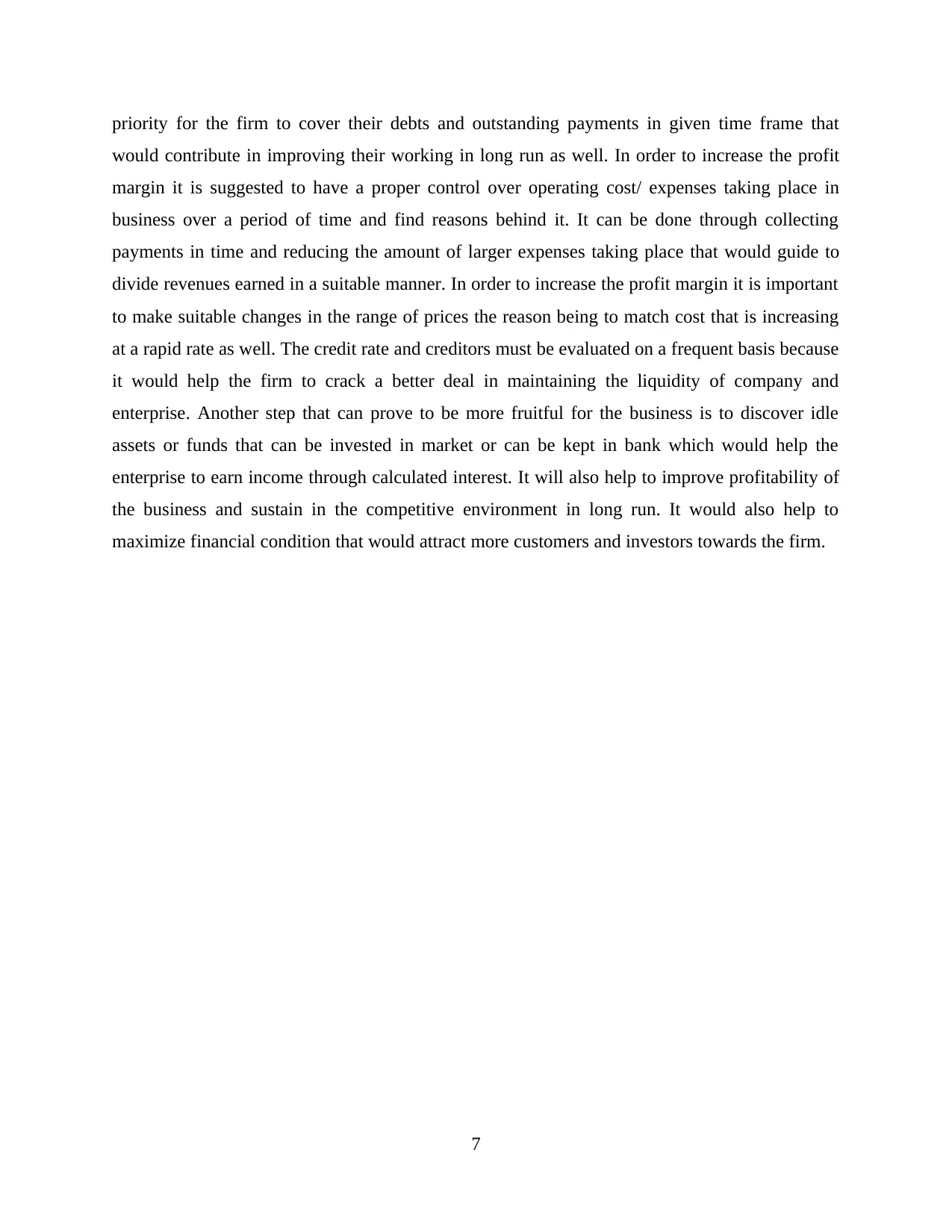
priority for the firm to cover their debts and outstanding payments in given time frame that
would contribute in improving their working in long run as well. In order to increase the profit
margin it is suggested to have a proper control over operating cost/ expenses taking place in
business over a period of time and find reasons behind it. It can be done through collecting
payments in time and reducing the amount of larger expenses taking place that would guide to
divide revenues earned in a suitable manner. In order to increase the profit margin it is important
to make suitable changes in the range of prices the reason being to match cost that is increasing
at a rapid rate as well. The credit rate and creditors must be evaluated on a frequent basis because
it would help the firm to crack a better deal in maintaining the liquidity of company and
enterprise. Another step that can prove to be more fruitful for the business is to discover idle
assets or funds that can be invested in market or can be kept in bank which would help the
enterprise to earn income through calculated interest. It will also help to improve profitability of
the business and sustain in the competitive environment in long run. It would also help to
maximize financial condition that would attract more customers and investors towards the firm.
7
would contribute in improving their working in long run as well. In order to increase the profit
margin it is suggested to have a proper control over operating cost/ expenses taking place in
business over a period of time and find reasons behind it. It can be done through collecting
payments in time and reducing the amount of larger expenses taking place that would guide to
divide revenues earned in a suitable manner. In order to increase the profit margin it is important
to make suitable changes in the range of prices the reason being to match cost that is increasing
at a rapid rate as well. The credit rate and creditors must be evaluated on a frequent basis because
it would help the firm to crack a better deal in maintaining the liquidity of company and
enterprise. Another step that can prove to be more fruitful for the business is to discover idle
assets or funds that can be invested in market or can be kept in bank which would help the
enterprise to earn income through calculated interest. It will also help to improve profitability of
the business and sustain in the competitive environment in long run. It would also help to
maximize financial condition that would attract more customers and investors towards the firm.
7
⊘ This is a preview!⊘
Do you want full access?
Subscribe today to unlock all pages.

Trusted by 1+ million students worldwide
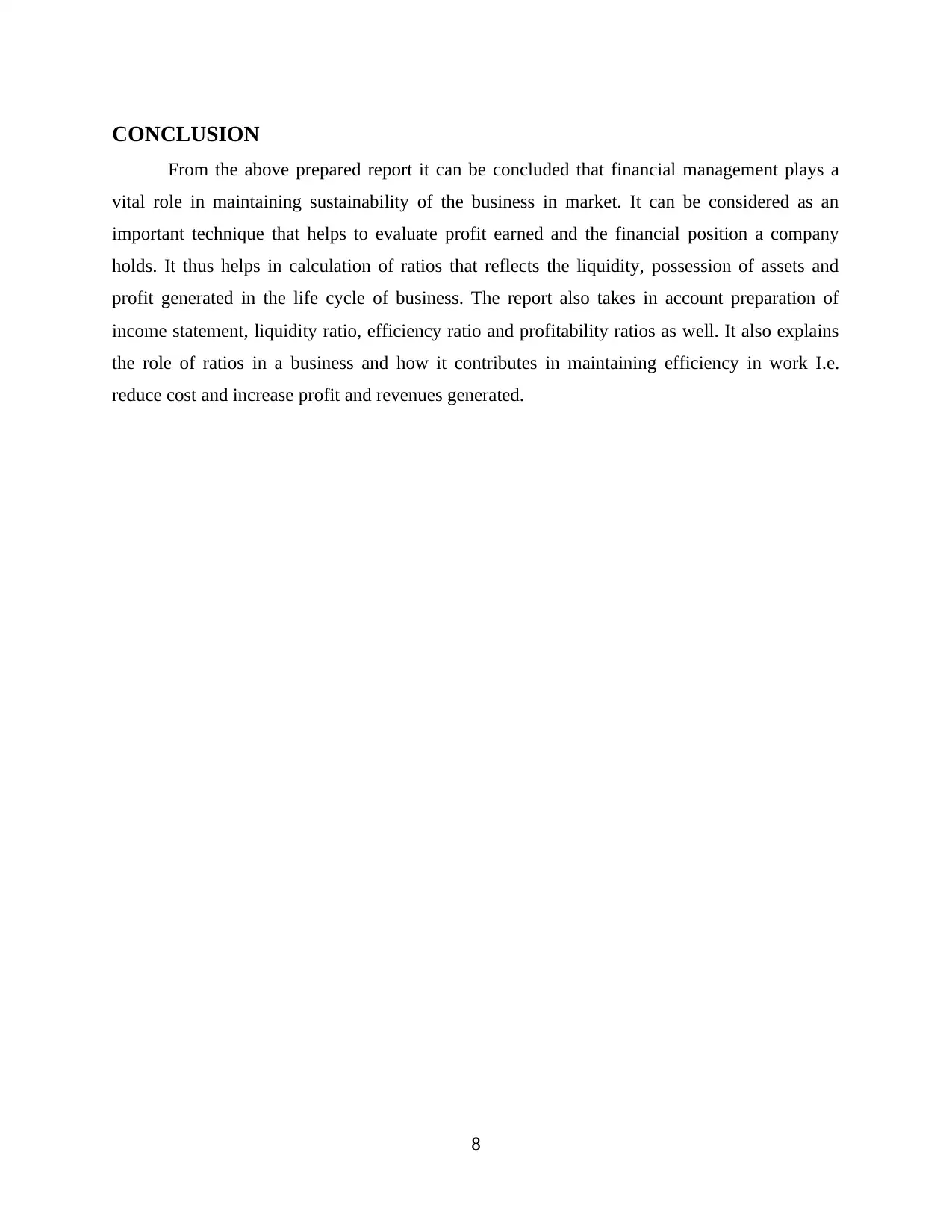
CONCLUSION
From the above prepared report it can be concluded that financial management plays a
vital role in maintaining sustainability of the business in market. It can be considered as an
important technique that helps to evaluate profit earned and the financial position a company
holds. It thus helps in calculation of ratios that reflects the liquidity, possession of assets and
profit generated in the life cycle of business. The report also takes in account preparation of
income statement, liquidity ratio, efficiency ratio and profitability ratios as well. It also explains
the role of ratios in a business and how it contributes in maintaining efficiency in work I.e.
reduce cost and increase profit and revenues generated.
8
From the above prepared report it can be concluded that financial management plays a
vital role in maintaining sustainability of the business in market. It can be considered as an
important technique that helps to evaluate profit earned and the financial position a company
holds. It thus helps in calculation of ratios that reflects the liquidity, possession of assets and
profit generated in the life cycle of business. The report also takes in account preparation of
income statement, liquidity ratio, efficiency ratio and profitability ratios as well. It also explains
the role of ratios in a business and how it contributes in maintaining efficiency in work I.e.
reduce cost and increase profit and revenues generated.
8
Paraphrase This Document
Need a fresh take? Get an instant paraphrase of this document with our AI Paraphraser
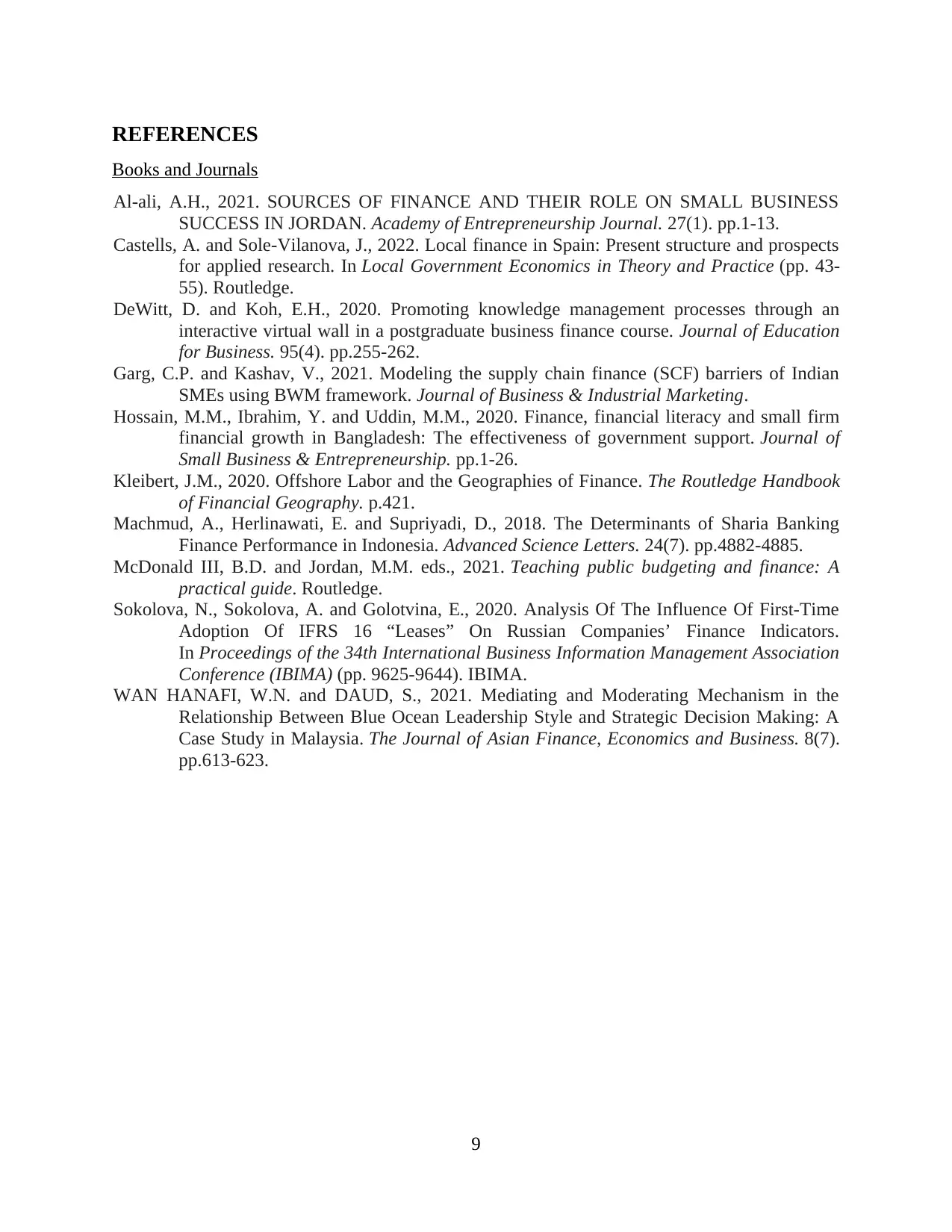
REFERENCES
Books and Journals
Al-ali, A.H., 2021. SOURCES OF FINANCE AND THEIR ROLE ON SMALL BUSINESS
SUCCESS IN JORDAN. Academy of Entrepreneurship Journal. 27(1). pp.1-13.
Castells, A. and Sole-Vilanova, J., 2022. Local finance in Spain: Present structure and prospects
for applied research. In Local Government Economics in Theory and Practice (pp. 43-
55). Routledge.
DeWitt, D. and Koh, E.H., 2020. Promoting knowledge management processes through an
interactive virtual wall in a postgraduate business finance course. Journal of Education
for Business. 95(4). pp.255-262.
Garg, C.P. and Kashav, V., 2021. Modeling the supply chain finance (SCF) barriers of Indian
SMEs using BWM framework. Journal of Business & Industrial Marketing.
Hossain, M.M., Ibrahim, Y. and Uddin, M.M., 2020. Finance, financial literacy and small firm
financial growth in Bangladesh: The effectiveness of government support. Journal of
Small Business & Entrepreneurship. pp.1-26.
Kleibert, J.M., 2020. Offshore Labor and the Geographies of Finance. The Routledge Handbook
of Financial Geography. p.421.
Machmud, A., Herlinawati, E. and Supriyadi, D., 2018. The Determinants of Sharia Banking
Finance Performance in Indonesia. Advanced Science Letters. 24(7). pp.4882-4885.
McDonald III, B.D. and Jordan, M.M. eds., 2021. Teaching public budgeting and finance: A
practical guide. Routledge.
Sokolova, N., Sokolova, A. and Golotvina, E., 2020. Analysis Of The Influence Of First-Time
Adoption Of IFRS 16 “Leases” On Russian Companies’ Finance Indicators.
In Proceedings of the 34th International Business Information Management Association
Conference (IBIMA) (pp. 9625-9644). IBIMA.
WAN HANAFI, W.N. and DAUD, S., 2021. Mediating and Moderating Mechanism in the
Relationship Between Blue Ocean Leadership Style and Strategic Decision Making: A
Case Study in Malaysia. The Journal of Asian Finance, Economics and Business. 8(7).
pp.613-623.
9
Books and Journals
Al-ali, A.H., 2021. SOURCES OF FINANCE AND THEIR ROLE ON SMALL BUSINESS
SUCCESS IN JORDAN. Academy of Entrepreneurship Journal. 27(1). pp.1-13.
Castells, A. and Sole-Vilanova, J., 2022. Local finance in Spain: Present structure and prospects
for applied research. In Local Government Economics in Theory and Practice (pp. 43-
55). Routledge.
DeWitt, D. and Koh, E.H., 2020. Promoting knowledge management processes through an
interactive virtual wall in a postgraduate business finance course. Journal of Education
for Business. 95(4). pp.255-262.
Garg, C.P. and Kashav, V., 2021. Modeling the supply chain finance (SCF) barriers of Indian
SMEs using BWM framework. Journal of Business & Industrial Marketing.
Hossain, M.M., Ibrahim, Y. and Uddin, M.M., 2020. Finance, financial literacy and small firm
financial growth in Bangladesh: The effectiveness of government support. Journal of
Small Business & Entrepreneurship. pp.1-26.
Kleibert, J.M., 2020. Offshore Labor and the Geographies of Finance. The Routledge Handbook
of Financial Geography. p.421.
Machmud, A., Herlinawati, E. and Supriyadi, D., 2018. The Determinants of Sharia Banking
Finance Performance in Indonesia. Advanced Science Letters. 24(7). pp.4882-4885.
McDonald III, B.D. and Jordan, M.M. eds., 2021. Teaching public budgeting and finance: A
practical guide. Routledge.
Sokolova, N., Sokolova, A. and Golotvina, E., 2020. Analysis Of The Influence Of First-Time
Adoption Of IFRS 16 “Leases” On Russian Companies’ Finance Indicators.
In Proceedings of the 34th International Business Information Management Association
Conference (IBIMA) (pp. 9625-9644). IBIMA.
WAN HANAFI, W.N. and DAUD, S., 2021. Mediating and Moderating Mechanism in the
Relationship Between Blue Ocean Leadership Style and Strategic Decision Making: A
Case Study in Malaysia. The Journal of Asian Finance, Economics and Business. 8(7).
pp.613-623.
9
1 out of 11
Related Documents
Your All-in-One AI-Powered Toolkit for Academic Success.
+13062052269
info@desklib.com
Available 24*7 on WhatsApp / Email
![[object Object]](/_next/static/media/star-bottom.7253800d.svg)
Unlock your academic potential
Copyright © 2020–2025 A2Z Services. All Rights Reserved. Developed and managed by ZUCOL.




